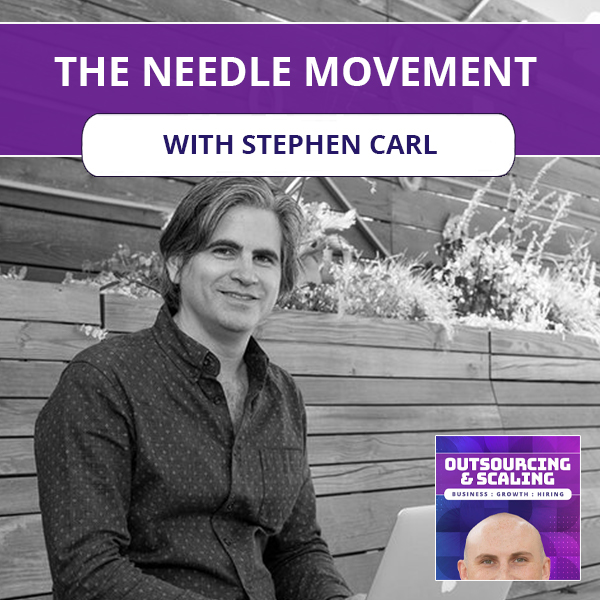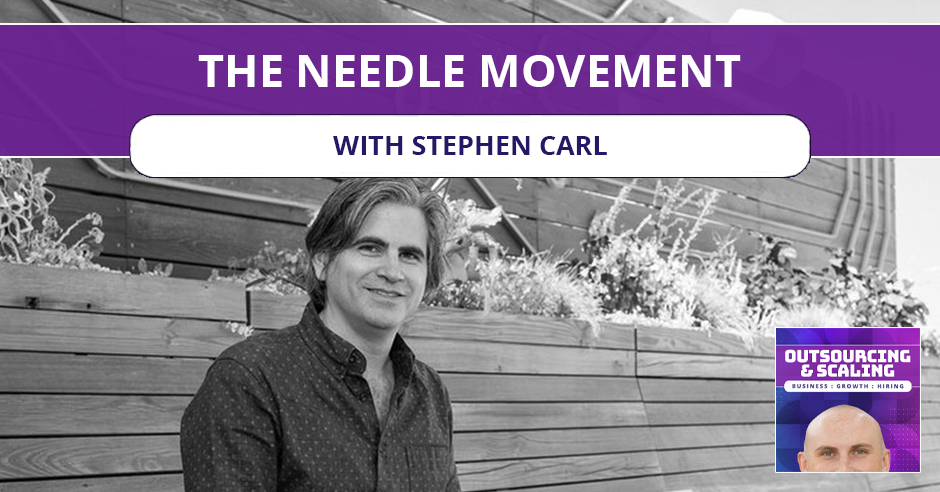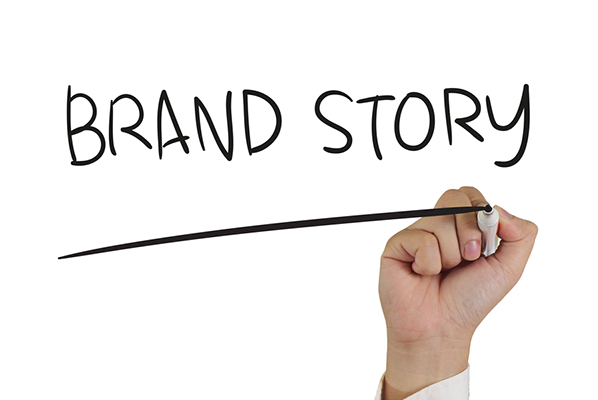


A lot of times with businesses, business models evolve to try and make the business more profitable. However, for early adapter cultures, embracing the change becomes a challenge. Joining Nathan Hirsch for this episode is Stephen Carl. Stephen is the Founder of Needle Movement, a digital strategy company focused on the conscious eCommerce. Starting his digital career as an early contractor at an Amazon funded startup in 1998, Stephen has been chasing online conversions ever since. Today, he talks about the emerging wave of retail brands and making a real difference through sustainable and social impact.
—
Listen to the podcast here:
[smart_track_player url=”https://www.podetize.com/statsapi/www.podetize.com/wp-content/uploads/fileuploads/11-5b145ef137b51b3d1af0633e9305c43d/02/2020/0b1807c47cc35dc91e2b3ace24814775.mp3″ title=”The Needle Movement With Stephen Carl” ]
Download the audio file here.
The Needle Movement With Stephen Carl
My guest is Stephen Carl. Stephen, how are you doing?
I’m doing great, Nathan. Thanks for having me on.
I’m excited to talk to you. Thanks for being here. For those of you who don’t know, Stephen is the Founder of Needle Movement, a digital strategy company focused on the conscious eCommerce. He began his digital career as an early contractor at an Amazon-funded startup in 1998 and has been chasing online conversions ever since. His past digital marketing experiences cover a wide array of categories, not-for-profit, luxury fashion, home and much more. A common thread of translating early digital trends into revenue growth. With Needle Movement, Stephen decided that his true calling was to take part in the greater good, which we’re going to talk all about the emerging wave of retail brands and make a real difference through sustainable and social impact. First, let’s take a gigantic step back. What were you like growing up? I know you said you’d been in eCommerce for many years, which is crazy to me. Tell me more. Were you a straight-A student? Were you a rebel? Did you always know that you wanted to be an entrepreneur?
I was a bit of a rebel. I was a Goth kid in a suburban high school. That’s what I was like growing up. I never imagined myself working in an office. That’s what is awesome about what’s happened with the internet over the past years.
Tell me more about your first eCommerce experience. What was that Amazon funded company? What was that like? What was eCommerce even like back then?
In 1998, I remember this was about the same time that Google was starting up before email and before anything with search engine marketing. I worked at a company called Kozmo.com, which did one-hour delivery in New York City by bicycle, bringing DVDs, food and drugstore products to people’s door. That company was interesting because I got to see instant gratification. I was an early contractor there and we do a little bit of everything. There are times where people would place an order, I would hop on a bike and deliver it to them, eight minutes after they ordered. I saw from an early point how you can blow people’s minds away. This started in New York City and it eventually expanded to ten cities, and Amazon gave money to the company. They gave $60 million to Kozmo.com. Unfortunately, that wave of companies in 2000 with the dot-com bubble, it didn’t last. A real lesson that I saw from it was how even though at first, Amazon had a failure with instant delivery, they still kept on going with that concept and it has done very well for them as you can see.
How did people react to instant delivery back then? I feel like eCommerce was new, never mind getting something delivered to you within an hour. It must have blown people’s minds. I almost feel like it was too early and was ahead of its time.
It did blow people away. A lot of times with businesses, it’s just the business model evolves and how you can turn it into a profitable business. People like this type of service.
Can you tell me more about your story and how that developed? I’m assuming you left that company. What happened after that?
After I left Kozmo.com, I had my first not-for-profit experience working at the 92nd Street Y, which is this large cultural institution. I spent the next thirteen years being the first eCommerce hire inside of companies. It would be my job to bring that digital culture and be the web guy. I show people how to do digital marketing, how eCommerce works, how shopping is different and how the logic is different on it. I would be assigned to holistically look over the business and also expand the business as it grew.

What were some lessons and takeaways from that?
I think the lesson is we’re in an early adapter culture and embracing the change that goes on, there’s always going to be a little bit of friction. The people that do the best in organizations are the ones that accept change, they don’t want to go back. With digital, we’re changing shopping and we would work together to make all the components of the business work. That was a huge lesson on it that you have to keep rolling with it. A lot of things are about comfort zones. Things are always going to be different every couple of years. You have to not do the thing that worked years ago that you heard about. You’ve got to always refresh and remind yourself of what’s working now, not what’s worked the last time you did it.
We’re both in the eCommerce industry. You see a lot of people that are like, “I’m a Shopify seller. I’m an Amazon seller.” You’ve got the digital marketing agencies and the influencers. I feel like that the real clash is not only starting to begin, but people are realizing it. They want to have a long-term business. It’s almost one and the same. Are you seeing the same thing? What would you say to that entrepreneur that’s trying to get out of the mentality of being an Amazon seller more towards being a brand?
The direction is going towards brands because the shopper doesn’t care and they have many different options of where they can purchase products. I find this in Shopify world too. One of my favorite parts about appearing on shows like yours and getting to know people in different verticals is you see that there are silos. You want to make your product available in multiple places because some people are not going to want to go to a website to purchase. They might not shop as much on Amazon. They might like to shop in physical stores. If you’re a brand and you’re selling products, you want to find a way to get into all these niches. It accelerates your learning as well to get that feedback from customers in different storefronts. The key is the differentiators too of how your product can stand out and be in its own niche and separate itself from a lot of similar types of products.
A big part of eCommerce is hiring. There are different ways to hire for eCommerce businesses, to build your brand, for digital marketing. What has your experience been hiring remotely?
It creates many opportunities for businesses. I remember the way it used to be where the business owner would be like, “I don’t know if I’m ready to bring on that hire.” Now you have multiple choice when you’re deciding to bring in new resources. You can hire someone for a project or you can hire someone that’s a consistent part-time consultant. It allows you to dip your feet in before you have to jump in. I think also of affordability and profitability. A lot of times with hiring, when companies first do it, it’s hard to know exactly what to do. We all make mistakes when we first bring on hiring. That’s why it’s helpful to have consultants and for newer companies, to start with positions and bring on a consultant or two, and then eventually you learn what can be the blueprint for a full-time position or a longer-term position within the company.
Can you give people a glimpse behind the scenes of Needle Movement? What is the structure of the business? How many people do you have? Are they remote? Are they in person? What are VAs? What are freelancers? Do you have project managers?
Needle Movement does function as a remote agency. It’s virtual, then we have people that are working on account management. It’s basically working with remote consultants where digital strategy is the focus of the company. We’re trying to be that second brain or that retailer of that brand. I’ve been there through my time in the corporate world doing eCommerce. I know how hard it is to holistically look over all these different aspects of the business. We handle the digital strategy portion and then we typically work with consultants and agencies to cover any gaps or holes within the company. We know that brands need a strong organic marketing strategy. There are many holes to fill between the website, email, their search presence, social media and branding. We work like that. We own the digital strategy part because we want our clients and brands to make the best possible decisions. The best decisions mean the big marketing wins. We all learn from our mistakes. Our mistakes can be expensive sometimes. That’s why at Needle Movement, we want to have the digital strategy that brings best practices.
What are the most common mistakes that you see? Let’s say you go into a company and they hire you. What are those?
Branding gets misunderstood sometimes. I’ve heard a lot of four-letter words pointed at certain marketing channels, “This ad suck, this doesn’t work. I hate this platform.” A lot of it has to do with creative and a lot of it has to do with how persuasive your brand is. That branding piece, when you see what doesn’t work, one of the first places to look at if it isn’t working like, “Why aren’t these Facebook ads working?” or “Why does a website have a low conversion rate?” A lot of times, it points to the information that’s presented. Also as eCommerce is evolving, every brand is more than just a store. Brands are becoming people and we all see this. Sometimes, you have to give the customer a little bit more than just, “I have a product and I’m selling it in a store.” In many ways, a store is becoming a social media profile, when years ago, it was just a store online.

That’s interesting to talk about. The customers are evolving as well.
Customers are very tribal. It’s like a type of music. There are going to be some people into hip-hop. There are going to be some people into heavy metal. There are going to be some people into classical music. What I’m noticing is a growing segment of people and consumers that are voting with their dollars. They see things like sustainability as important. They want the dollars that they spend to go to people that are going to pass those dollars on and have some social impact. The other thing is because consumers have many options. It makes a difference to them in their buying decision about what the company they’re buying from is doing and what types of causes they’re involved with.
What are some things that brands can do to stand out when it comes to that?
I have a few things. They apply to all businesses, but in mission-driven and sustainable businesses, this becomes more apparent. Number one, take a hard look at your about us page and the way that you’re presenting your brand story. That’s one of the first places I look. If it was just a generic message or it doesn’t have a picture of the company, that’s something that is not a persuasive message to the consumer. Find a way to position your brand story that, “These are my values. This is what I believe in.” A lot of times, even for small businesses, people don’t want to buy from faceless corporations. If you’re a family-owned business that strongly believes in a product that’s backing it up, that means so much. The brand story and presenting it on the site is important.
Number two, there is a growing amount of sustainability. Look at the packaging. Something that people don’t talk about so often is the unboxing process, that magical moment when someone opens the package. You can turn off somebody if it’s generic. Fortunately, there are a lot of professional companies that do packaging. People are also conscious of the amount of packaging like, “Is that packaging recyclable or compostable?” You might say to yourself, “I love to do that but it’s impossible.” There are companies that are doing this. There’s a company called No Issue that does a compostable mailer. As the sustainable market is getting bigger, the costs are going down for retailers to provide this. Some of this packaging looks cool. That’s the first experience you want people to see on that first order. They had this great unboxing appearance and they see that the consumer is doing everything they can.
Number three, trust signals and trust seals are important. On the product page, give guarantees, give people reasons to buy. If that product is cruelty-free, if that product is vegan, if there are things that differentiate, put markers that indicate it. Another thing that a company can do on a larger scale is there are companies that are becoming B-corporations. They’re signing up with organizations like 1% for the planet. They’re putting those seals at the bottom of the website to tell people, “This is more than selling products. We believe in our workers. We believe in our relationships with our suppliers. We believe in our contractors.” It’s giving people another reason to purchase. Those things, like packaging, are not outrageously expensive. They’re very viable.
Number four is give-back programs like TOMS Shoes and Warby Parker popularize these where they’re like, “Buy one of this and we’ll do this for the company.” Those things can be compelling to consumers. It’s something that when you have it, it almost replaces your marketing program. You can plaster that everywhere, on your email marketing, and through the checkout process. It can help improve your conversion rate. Also, a lot of businesses have one-time buyer problems. This is a great way to get people to purchase again when they go, “I’m buying this product but I’m also helping this cause that I like as well.” That makes a difference. Number five would be being authentic. People want their companies to stand up for something. Tell them what you believe in and be sincere. There are many companies that are already involved in charities and care deeply about their customer service. This mission-driven component is another extension of what you’re already thinking and how to augment that and present it.
How does your marketing plan change? Once you add those to your website or you have that mission behind it, how can you go about using Facebook ads or LinkedIn or Instagram to take it to the next level?
The marketing message on your website is like adding content, mentioning those causes that you’re involved in and placing it in important spots. On the product page, you could place it on the bottom of the website, you could place it in about us, in your Instagram stories. The mission-driven initiatives or the causes you care about, those can become the story. People like it when you’re not just talking about products. If you can talk about the impact and tell a story about the person you helped. I have a client who makes caftan dresses. She has a scholarship program that is a beneficiary of some of the sales from that program. She tells the story about the people that receive those scholarships. That’s a way to personalize it.

What else did we miss?
I think we covered a lot. I will go through two myths of it that I briefly went through. A lot of people want to get involved in more conscious causes. They think, “I’d love to do this but it’s impossible.” Seeing a lot of these companies and their success. There are eye-dropping numbers for some companies that are mission-driven like Allbirds. They have a $1.4 billion evaluation. Everlane is making over $100 million in sales. Bombas made over $100 million and they’re selling socks. It’s very viable. Times are changing as more companies are getting into this space. It’s not as difficult to do as it was before.
Is there a certain percentage that you have to give in order to make that impactful? Is there a certain industry average? A lot of people are running a small business. Let’s say they’re doing $1 million a year and they might have a 20% to 25% margin. They’re thinking to themselves, “If I give away 5% of my margin, I can put it on my website. That’s going to impact me. It’s going to impact the people that work for me.” Is there a standard there?
There’s not a magic number there. Typically, a company will devote a certain percentage. It could be 5% just to give you a benchmark. The most important thing is there’s a cause and they’re transparent about what they have. There’s not a high threshold for it. A lot of businesses are doing that cause as a component of it, but it’s not a highly restrictive requirement.
Stephen, thanks so much for coming on. I appreciate it. Where can people find out more about you and what are you most excited about?
I’m excited about 2020 because we’re starting to realize that this is the end of this decade and we’re going to end it strong. My company’s name is Needle Movement, as in move the needle. You can send me an email at Hello@NeedleMovement.com. I look at all the emails and I will answer them. I’m happy to give anyone coming on from this show a free audit and as a starter kit for mission-driven eCommerce. I know a lot of people are curious and we can talk about how your brand can ride this wave and become more sustainable.
Stephen, thanks for coming on.
Thanks for having me on, Nathan. It was a great talk.
Important Links:
- Needle Movement
- Kozmo.com
- 92nd Street Y
- No Issue
- TOMS Shoes
- Warby Parker
- Allbirds
- Everlane
- Bombas
- Hello@NeedleMovement.com
About Stephen Carl
 Stephen Carl is the founder of Needle Movement, a digital strategy company focused on conscious eCommerce. Stephen began his digital career as an early contractor at an Amazon-funded start-up in 1998 and has been chasing online conversions ever since. His past digital marketing experiences cover a wide array of categories: not-for-profit, luxury fashion, home, and horticulture – all with the common thread of translating early digital trends into revenue growth.
Stephen Carl is the founder of Needle Movement, a digital strategy company focused on conscious eCommerce. Stephen began his digital career as an early contractor at an Amazon-funded start-up in 1998 and has been chasing online conversions ever since. His past digital marketing experiences cover a wide array of categories: not-for-profit, luxury fashion, home, and horticulture – all with the common thread of translating early digital trends into revenue growth.
With Needle Movement, Stephen decided that his true calling was to take part in the greater good – the emerging wave of retail brands that make a real difference through sustainability and social impact. He helps these mission-driven brands navigate the wild world of digital marketing, steering them towards the big wins and away from expensive mistakes. Stephen lives in Brooklyn, is a vegetarian and tends to get animated when discussing single-use plastics. He has had previous speaking engagements at Luxury Interactive, SearchCon and Predictive Summit.
